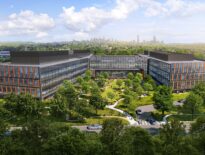
Pennrose’s redevelopment of two former elementary schools in Auburn, including the Mary D. Stone School, will generate 125 mixed-income rental housing units for seniors. Image courtesy of DiMella Shaffer.
With COVID-19 reopening underway in Massachusetts, developers across the region are reevaluating strategies to echo current market conditions and better meet the needs of communities and residents.
Many development procedures and building processes are beginning to go “back to normal” with additional layers of protections in place to keep communities healthy. Looking ahead, developers must consider some of the challenges and opportunities on the horizon.
Generating new business has been increasingly challenging these past few months. Mandated social distancing guidelines have delayed in-person town meetings and other traditional face-to-face interactions that are critical for relationship building. Developers need to be flexible and think creatively about connecting with local officials and project partners.
For example, virtual meetings have become commonplace and are likely here to stay. In fact, Pennrose was designated as developer for a mixed-income family and senior deal in a South Shore town entirely through Zoom meetings in April. Town meetings that were postponed are also now being arranged in larger, outdoor spaces with safety guidelines established for all attendees.
Most recently, Pennrose attended a town meeting on a football field in Auburn to get final approvals for the redevelopment of the Mary D. Stone School, the first of two developments in Auburn including the site of former Julia Bancroft School, which will create a total of 125 new rental units of mixed income housing for seniors.
Anticipating New Costs and Fluctuations
From a construction standpoint, budgets have been impacted due to contractors pricing for extra safety protections. In some cases, general contractors are seeing better pricing, or at least stabilized pricing from subcontractors due to a shortage of work, while others are pricing up in case additional precautions slow work pace.
This is new territory for developers to navigate, but costs are expected to steady as cities and towns reopen and contractors gain a better understanding of standard precautions moving forward. Until then, developers should account for extra costs and work closely with contractors when budgeting.
Equity pricing is also a challenge. Some investors have become less aggressive in seeking new business, which has impacted tax credit pricing, particularly in non-Community Reinvestment Act markets. Lenders are looking for higher debt service coverage ratios, larger reserves and requiring that construction loan interest line items be increased for additional cushion.
Income limits in affordable housing developments may also see a shift. Income limits have generally increased on a year-to-year basis, resulting in higher allowable rents. Due to current market conditions, there is concern that income limits will drop, not necessarily next year but the following, since there is often a lag in data. This is particularly concerning for deals closing now that will lease up in two years, due to the potential that rents used now to size the permanent debt will be lower, resulting in insufficient revenue to support the projected permanent debt. Developers of LIHTC deals have the option to lock in the income limits now as a floor for future rents or wait until the development is completed. While most developers have waited to lock in the income limits later, that decision should be reevaluated.
With unemployment rates continuing to increase, the housing industry has been very concerned with both the pace of leasing and rent collections taking a hit. Through clear and transparent communication, extensive cleaning procedures and enhanced supportive services delivery, residents see what their rent is going towards and understand the value of paying on time.
Pennrose also established the COVID-19 Resident Relief Fund to help tenants who were adversely impacted by the pandemic, and will work with them to develop payment schedules or connect them with other emergency relief resources. The relationship between tenants and management is tight-knit, and it’s important to foster good will at every turn.
Addressing the Need for Affordable Housing
Now, more than ever, communities in New England and throughout the country are in need of high-quality, safe and affordable housing options. In fact, at Village at Nauset Green, a new affordable and workforce Cape Cod-style rental community in Eastham, Pennrose has seen a spike in applications. At the state and city level, there are mechanisms and leadership in place to recognize this increased demand.

Charlie Adams
However, misconceptions in the community around affordable housing and the relationship between the pandemic and density poses a threat to development. It’s important to educate local neighborhoods that the real issue isn’t density, but rather overcrowding. The coronavirus has put a spotlight on the number of individuals dramatically underhoused and the production of affordable housing can help remediate this issue. Community engagement is also important to ensure that new residential communities are tailored to meet the needs of individual neighborhoods.
While the housing industry continues to recover from COVID-19, there is opportunity for housing developers ahead. It is critical for developers to use this time in the early stages of reopening to evaluate new and forthcoming challenges and adjust plans to better suit the individuals and communities they serve.
Charlie Adams is a regional vice president at Pennrose overseeing its New England area operations.




 |
| 

